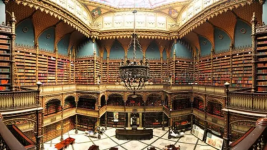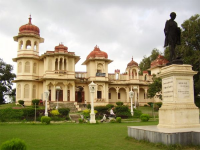You are using an out of date browser. It may not display this or other websites correctly.
You should upgrade or use an alternative browser.
You should upgrade or use an alternative browser.
Library Lovers' Day (February 14)
- Thread starter Phil D
- Start date
SpaceCadet
Quiet Reader
Surprisingly, although I love books and I enjoy being surrounded by books, I have not developed that sort of 'love' relationship with libraries that you guys are talking about.
EDIT: There were no public library near where I grew up and my parents never took me to any. And although during school term, I did spend a fair amount of time at my school library, I soon found it was not too well stocked. That probably did not help the matter.
So I agree with you that, whether they are of the physical type (my preference) or the virtual one, small or big, libraries are absolutely necessary.
As for my favorite library I must admit I have a soft spot for The Library of Babel (by Borges).
EDIT: There were no public library near where I grew up and my parents never took me to any. And although during school term, I did spend a fair amount of time at my school library, I soon found it was not too well stocked. That probably did not help the matter.
So I agree with you that, whether they are of the physical type (my preference) or the virtual one, small or big, libraries are absolutely necessary.
As for my favorite library I must admit I have a soft spot for The Library of Babel (by Borges).
Last edited:
Benny Profane
Well-known member
I was never there, but our dear friend @Bartleby is carioca (from Rio de Janeiro) and he, probably, was there.Coincidentally, today I've been reading poems by Cecília Meireles, who happened to set up Brazil's first ever children's library, in Botafogo, Rio de Janeiro, in 1934. Do any of our Brazilian friends know if it's still there? Have you ever visited?
In my born city, there is a library for children called Monteiro Lobato in his honour. Monteiro Lobato was the first Brazilian author who wrote extensively works for children and young adults.
Last edited:
Stevie B
Current Member
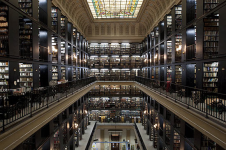
This would be a great place to house my book collection, but I'm afraid it's not big enough. Just kidding. At last count, my collection still numbered fewer than 1000 books. I'm hoping some WLF members will tell me their collections are bigger so that I don't feel so guilty (or embarrassed).
Last edited:
Benny Profane
Well-known member
This is the first Public Library from Brazil.
It was located in my born city, Salvador. It was burned by our "wonderful" Armed Forces in 1912 due to political motivations. As usual, my city always being bombed, burnt, hated and suffering xenophoby by our central Government.
Beautiful bulding built on 1909:
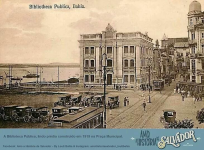
Palácio do Rio Branco [the first Royal Cabinet in Brazil - the Public Library was there until 1909]:
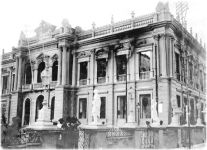
https://albenisio.wordpress.com/2018/05/13/bibliotecapublica/ [More here. Unfortunetaly, in Portuguese].
It was located in my born city, Salvador. It was burned by our "wonderful" Armed Forces in 1912 due to political motivations. As usual, my city always being bombed, burnt, hated and suffering xenophoby by our central Government.
Beautiful bulding built on 1909:

Palácio do Rio Branco [the first Royal Cabinet in Brazil - the Public Library was there until 1909]:

https://albenisio.wordpress.com/2018/05/13/bibliotecapublica/ [More here. Unfortunetaly, in Portuguese].
Leseratte
Well-known member
Welcome back,Benny. Hope you had a very electric carnival!
Benny Profane
Well-known member
Yes, I had a wonderful Carnival locked in my room with a lot of books of Economics, Constitutional Law and Public Policy. ?Welcome back,Benny. Hope you had a very electric carnival!
Last edited:
Bartleby
Moderator
I was looking this up on the internet, and it appears that this library only worked from 1934 to 1937. Here's an old photo:Coincidentally, today I've been reading poems by Cecília Meireles, who happened to set up Brazil's first ever children's library, in Botafogo, Rio de Janeiro, in 1934. Do any of our Brazilian friends know if it's still there? Have you ever visited?

tiganeasca
Moderator
Funny how your memory works. I have such wonderful memories of the library I spent countless hours in when I was a kid: downstairs was entirely for children and upstairs for adults. In the late 19th century, Andrew Carnegie (a Scottish immigrant to the US who made a fortune in the steel industry) personally paid for the building of libraries across the entire country. According to Wikipedia, "2,509 Carnegie libraries were built between 1883 and 1929." Indeed, he donate nearly $60 million dollars for the libraries alone as well as additional monies for all kinds of charitable purposes...an extraordinarily public-minded and generous man. Mine was one of those libraries. Looking back, wonderful memories notwithstanding, I can see now that the outside was, at best, not particularly, um, inviting.


Last edited:
Phil D
Well-known member
There are Carnegie libraries across the whole English-speaking world. There's even a suburb of Melbourne, Australia, named 'Carnegie' in his honour that borders the neighbourhood where I grew up – although even with the name change they missed out on library funding.2,509 Carnegie libraries were built between 1883 and 1929
tiganeasca
Moderator
Indeed you're quite right. I read too fast. The 2,509 encompasses libraries around the world. In the US, there are 1,689 and, according to the same sentence I quoted above but didn't read all the way through, there are 25 in Australia and other places such as Serbia, Belgium, South Africa, Malaysia and more! Wow! In fact, if anyone is interested, the story behind the libraries is fascinating.There are Carnegie libraries across the whole English-speaking world. There's even a suburb of Melbourne, Australia, named 'Carnegie' in his honour that borders the neighbourhood where I grew up – although even with the name change they missed out on library funding.
P.S. Based on the number in Wikipedia, it seems like the value of the money he spent over a hundred years ago would be in the vicinity of $2 billion (!!) now. Quite the generous chap!
Last edited:
Leseratte
Well-known member
And the blocos passing under the window. At least it was a useful way of spending carnival.Yes, I had a wonderful Carnival locked in my room with a lot of books of Economics, Constitutional Law and Public Policy. ?
Leseratte
Well-known member
Funny how your memory works. I have such wonderful memories of the library I spent countless hours in when I was a kid: downstairs was entirely for children and upstairs for adults. In the late 19th century, Andrew Carnegie (a Scottish immigrant to the US who made a fortune in the steel industry) personally paid for the building of libraries across the entire country. According to Wikipedia, "2,509 Carnegie libraries were built between 1883 and 1929." Indeed, he donate nearly $60 million dollars for the libraries alone as well as additional monies for all kinds of charitable purposes...an extraordinarily public-minded and generous man. Mine was one of those libraries. Looking back, wonderful memories notwithstanding, I can see now that the outside was, at best, not particularly, um, inviting.

Public reading in my city (within an institution) begins in the Popular Library organized in the University Library building. The Popular library, intended for the general public, was inaugurated on May 14, 1921. It had a hall with 70 seats and a warehouse, which held 1500 volumes in Romanian and 500 in Hungarian, approximately the number of books that @Stevie B has ?. In 1935, as a result of the increase in the book collection and the number of readers, the popular library will expand, operating in two reading rooms, with a total of 220 seats . One of the rooms was intended for children. "To keep the peace in the large reading room, the children were moved to room No. II, because in addition to all the orders and measures taken, the 6-8-10-year-old children with their movements and whispers disturbed the adult readers. Popular Library it is open not only on working days, but also on Sundays and holidays between 2-8 p.m., thus giving the working class the opportunity to take advantage of the library on days off as well. In winter, the younger children are sent home after 6 o'clock." (Barbul, Eugen (1935). Biblioteca Universității Regele Ferdinand I din Cluj).
In the 1950s the library has been moved to several locations due to the increase in the number of books, and in the 1960s they began to open branches in the neighborhoods. In the 1990s, being threatened with eviction from the building in which it was based, the County Council introduces a new building for the library in the investment plan, on a 5040 m² plot of land provided by the Municipal Council, outside the Historical Center, in the neighborhood where I grew up. In 2002 the new headquarters was inaugurated, almost every day I find a post with events, clubs that take place within the library. Yesterday, as part of the "I want to be a character in a story" project, children dramatized "The Human Stupidity" by Ion Creangă. I was fascinated by this story when my mom read it to me.
almost every day I find a post with events, clubs that take place within the library. Yesterday, as part of the "I want to be a character in a story" project, children dramatized "The Human Stupidity" by Ion Creangă. I was fascinated by this story when my mom read it to me.
In the 1950s the library has been moved to several locations due to the increase in the number of books, and in the 1960s they began to open branches in the neighborhoods. In the 1990s, being threatened with eviction from the building in which it was based, the County Council introduces a new building for the library in the investment plan, on a 5040 m² plot of land provided by the Municipal Council, outside the Historical Center, in the neighborhood where I grew up. In 2002 the new headquarters was inaugurated,
 almost every day I find a post with events, clubs that take place within the library. Yesterday, as part of the "I want to be a character in a story" project, children dramatized "The Human Stupidity" by Ion Creangă. I was fascinated by this story when my mom read it to me.
almost every day I find a post with events, clubs that take place within the library. Yesterday, as part of the "I want to be a character in a story" project, children dramatized "The Human Stupidity" by Ion Creangă. I was fascinated by this story when my mom read it to me.Leseratte
Well-known member
I'm amazed at these educate whispering children, who in spite of it seem to disturb the adults.Public reading in my city (within an institution) begins in the Popular Library organized in the University Library building. The Popular library, intended for the general public, was inaugurated on May 14, 1921. It had a hall with 70 seats and a warehouse, which held 1500 volumes in Romanian and 500 in Hungarian, approximately the number of books that @Stevie B has ?. In 1935, as a result of the increase in the book collection and the number of readers, the popular library will expand, operating in two reading rooms, with a total of 220 seats . One of the rooms was intended for children. "To keep the peace in the large reading room, the children were moved to room No. II, because in addition to all the orders and measures taken, the 6-8-10-year-old children with their movements and whispers disturbed the adult readers. Popular Library it is open not only on working days, but also on Sundays and holidays between 2-8 p.m., thus giving the working class the opportunity to take advantage of the library on days off as well. In winter, the younger children are sent home after 6 o'clock." (Barbul, Eugen (1935). Biblioteca Universității Regele Ferdinand I din Cluj).
In the 1950s the library has been moved to several locations due to the increase in the number of books, and in the 1960s they began to open branches in the neighborhoods. In the 1990s, being threatened with eviction from the building in which it was based, the County Council introduces a new building for the library in the investment plan, on a 5040 m² plot of land provided by the Municipal Council, outside the Historical Center, in the neighborhood where I grew up. In 2002 the new headquarters was inaugurated, View attachment 2418almost every day I find a post with events, clubs that take place within the library. Yesterday, as part of the "I want to be a character in a story" project, children dramatized "The Human Stupidity" by Ion Creangă. I was fascinated by this story when my mom read it to me.
Hamishe22
Well-known member
I'm not a huge library person. I want to own the books, and since I live in Iran, libraries mostly have books that are either translated into Persian (which I try to avoid) or are very standard fair that I have already read. My fantasies are mostly about bookstores rather than libraries.
That said, I have used university libraries a lot. They're the only ones that actually have extensive English books, and I especially use them for non-fiction books.
That said, I have used university libraries a lot. They're the only ones that actually have extensive English books, and I especially use them for non-fiction books.

